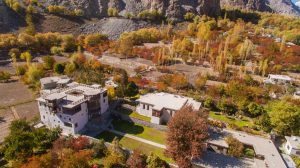
Makli Necropolis, A Hidden Gem in Sindh
October 26, 2021
Burzil Pass, Historic caravan route between the cities of Srinagar and Gilgit.
October 26, 2021
The rich history and cultural heritage of Pakistan have been a source of fascination for tourists for many years. The tourists can experience the vibrant history and culture of the country by visiting the multitude of forts and palaces that are dotted around the country, each with their own stories to tell. Khaplu Fort is among the most fascinating and iconic forts in the country. The fort is locally known as Yango Khar located in the eastern part of Baltistan, at an altitude of 2,600 meters above sea level.
History
The palace was built by Yabgo Raja Daulat Ali Khan, the ruler of Khalpu in 1840. According to the historic references, the location of the fort was decided by rolling a large stone down from a nearby cliff; it stopped at the Dosai village, and the palace was built there. According to Jane E. Duncan, the people of Khaplu were not allowed to build their own homes and have to live inside this fort. When the Maharaja of Kashmir captured the area, he changed this practice.
The ruler of Baltistan, Murad Khan of the Maqpon Dynasty had captured the fort in the 1590s in the Conquest of Khaplu by cutting off the water and other supplies to the fort. Murad’s army besieged the fort for almost months after which the 62nd Yabgo dynasty ruler of Khaplu, Rahim Khan. The fort again fell to invaders during the 1660s and 1674.
Even after the Yabgo kingdom was abolished in 1972, the descendants of Yabgo continued to live there. Raja Fatah Ali Khan, the last Raja of Khaplu who lived in the house and died in 1983.
Architecture
The architecture of the fort is a blend of Tibetan, Balti, Kashmiri, and Central Asian influences. The fort is made up of timber, clay, mud bricks, soil mortar, and comprises four floors. The carved wooden gate at the entrance of the fort took from the Skardu when Raja Hatim Khan, the Yabgo ruler conquered most of Baltistan.
The passage beyond the main entrance, which formerly housed a stable, leads to the front yard of the fort which was used by a musical band during celebrations in the rule of Yabgo Rajas. The wooden roof of the fort is made with designs using chisel and paint, without the use of nails. A hall on the top floor was used as a leisure room whereas other notable rooms inside the fort include Royal Balcony, the Royal meeting room, Queen room, and Princess dressing room.
The residential area of the fort is used as a hotel operated by Serena Hotels. The hotel has 21 rooms, six of which are located inside the fort and utilize its 70% of income for the maintenance and development of Khalpu, while another area serves as a museum.
